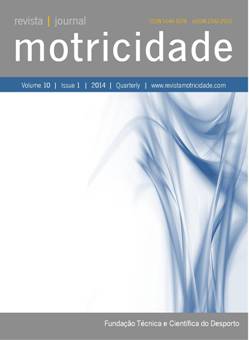Characterization of the defense-attack transition of a soccer team
DOI:
https://doi.org/10.6063/motricidade.1544Abstract
This study aimed to characterize the transition defense-attack in association football using the social networks analysis method. Four competitive matches from the 1st Portuguese League were analyzed with a total of 52 offensive patterns of play identified. Using SocNetV 0.81 software we computed the Betweenness (%BC) and In-Out centralities (%IDC and %ODC). Data showed that the team in analysis have two preferential patterns of play for this moment of game: i) supported play, with the defensive midfielder being the player that received more often the ball in the defensive central zone of the field and present the highest influence on the network of passing balls, and ii) direct play, with the centre forward being the player that received more long balls in the first offensive central zone or on the first right wing zone of the offensive midfield. It is also suggested that the number of players surrounding the ball allow the emergence of a short or long pass. Using this type of methodology is possible to better identify and quantify the patterns of play of a team, providing reliable data that help coaches to improve performance of their teams.
Downloads
Published
Issue
Section
License
The authors of submitted manuscripts must transfer the full copyright to Journal Motricidade / Sílabas Didáticas Editions. Granting copyright permission allows the publication and dissemination of the article in printed or electronic formats, and copyrights start at the moment the manuscript is accepted for publication. It also allows Journal Motricidade to use and commercialise the article in terms of licensing, lending or selling its content to indexation/abstracts databases and other entities.
According to the terms of the Creative Commons licence, authors may reproduce a reasonable number of copies for personal or professional purposes, but without any economic gain. SHERPA/RoMEO allows authors to post a final digital copy (post-printing version) of the article on their websites or on their institutions' scientific repository.


